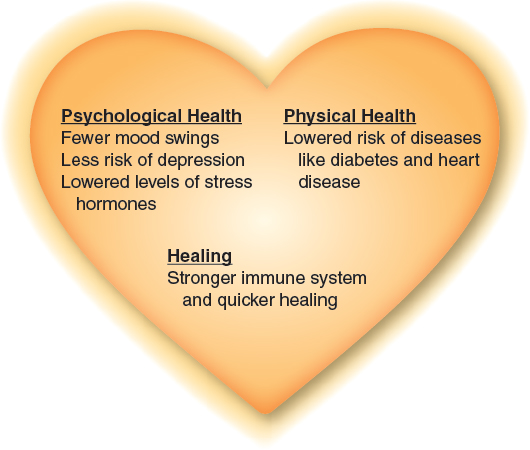Romantic Relationships
One of the best ways to react with empathy is through empathic listening (Chapter 6). By paraphrasing your friend’s words and using caring facial expressions and body movements (Chapter 4), you encourage your friend to share what’s on his mind—even if you have never had the experience that he’s describing.
What ideas, thoughts, and feelings come to mind when you think about romantic relationships? Do you think of romantic dinners, jealousy, butter-flies in your stomach? Perhaps you think about sex or about commitment and love (Tierney, 2007).
Love can be used to describe feelings other than romantic ones, including our feelings for our families, friends, pets, or anything that evokes strong feelings of like or appreciation (as in “I love the Chicago Bears” or “I love burritos”). But we typically define love within the context of relationships as a deep affection for and attachment to another person involving emotional ties, with varying degrees of passion, commitment, and intimacy (closeness and understanding of a relational partner). There are many types of love that can characterize different relationships—or even the same relationship at different times. For example, the love between Anna and Mario, married for fifty-seven years, is probably not the same as when they were first married. Studies involving hundreds of people revealed six categories of love: eros (erotic, sexual love), ludus (playful, casual love), storge (love that lacks passion), pragma (committed, practical love), mania (intense, romantic love), and agape (selfless, unconditional love) (Hendrick & Hendrick, 1992; Lee, 1973). Some relationships may be characterized by only one of these types, whereas others may move through two or more types over time.
The complexities of romantic love can be astounding, but the desire to attain it is as universal as it is timeless. In fact, the value of relationships and the characteristics that comprise love and commitment between two people are fairly consistent regardless of culture. One study found that among Americans, Chinese, Japanese, and Koreans, differences in notions of love were not pronounced, and respondents from all four countries reported that happiness and warmth were associated with love (Kline, Horton, & Zhang, 2005).

ROMANTIC COUPLES, regardless of sexual orientation, age, race, or ethnicity, all enjoy similar benefits of being in a relationship: intimacy and commitment. (top left) Mike Powell/Getty Images; (top right) © John Birdsall/The Image Works; (bottom left) ZHAO YINGQUAN/Xinhua/Landov; (bottom right) Hola Images/Getty Images
Studies show that relational harmony has both physical and psychological benefits, as you can see in Figure 7.1 (Parker-Pope, 2010a). However, research reveals that there isn’t one specific path to romantic satisfaction. Dating partners in both long-distance and geographically close relationships enjoy satisfaction through the use of compatible styles of humor and other coping skills to decrease relational stress (Hall, 2013; Vela, Booth-Butterfield, Wanzer, & Vallade, 2013). Same-sex couples in long-term, committed relationships share the same benefits of meaningful commitment (such as life satisfaction and general well-being) as heterosexual couples (Clausell & Roisman, 2009). Cohabitating unmarried couples who see themselves on a trajectory toward marriage enjoy similar satisfaction and well-being as married couples, but those who have ambiguity about their path or the future of the relationship are more at risk for negative relational outcomes (Willoughby, Carroll, & Busby, 2012).

Figure 7.1: FIGURE 7.1 EFFECTS OF RELATIONSHIP HARMONY
Figure 7.1: This figure represents some of the benefits that happy relationships might expect. Source: Parker-Pope, 2010a.

